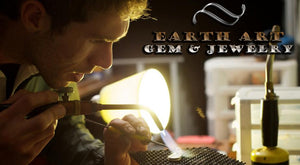Diamond Information
The Four C's
When you think of diamonds, now a days most people think of the 4 C's The jewelry industry has worked hard to create a consistent platform for consumer diamond information and this is a big part of that. The diamond grading system is set up so that a jeweler in New York can evaluate a diamond, and give it the same grade as a jeweler in Los Angeles.
To better explain Here is a simplified version of what these C's mean:
Carat
The Weight of a diamond is measured in carats, which is a unit of measurement. There are 5 carats in a gram. A one carat diamond is a measure of how much the stone weighs. Depending on how the stone is cut, the size can vary a fair amount. A note about size: In the jewelry industry, all sizes are measured in mm.
The more carats, the higher the stones value. In addition, this is not a liner scale. the cost per carat for a diamond rises exponentially as a stone increases in size, especially once a stone is larger than 1 carat. This is because larger stones are much more rare than smaller stones.
This is the biggest factor in the price of a diamond.
Color
The color of a diamond relates to how clear (White) versus how yellow a stone is. The scale goes from "D" to "Z".
A "D" color diamond is completely colorless. A "Z" diamond, also called canary or fancy, is a bright vivid yellow color.
Stones are typically more expensive, the more colorless they are.
My personal observation has been that stones in the D, E, F range are so colorless, that they have slightly less fire than that of a stone in the GHI color range. I typically use GHI color stones in my jewelry, because they are still so white, that it is hard to see much difference, especially for smaller stones.
Cut
The cut of a diamond can make a difference in several ways. The first is the quality of the cut. Is it symmetrical? Did the cutter use the proper angles to maximize the brilliance of the stone? Are all of the surfaces completely polished, or are there polishing marks? Second: How is the stone cut? Some diamond cutters have their own signature cut, which they market to increase the value of the stone, such as Heart On Fire diamonds as one example. And lastly, the shape of the cut: Is a round, marquise, fancy, oval? Different cuts go in and out of style, so a cut that may fetch a higher price in one decade, may be discounted in the future.
Clarity
e clarity of the stone, while last on the list, is probably the second most important in determining the price. The diamond industry has established 5 clarity grades. Within each of the grades are sub grades for further distinguishing the stones, although for smaller stones, these grades are sometimes lumped together since it can be so hard to tell them apart.
FL, IF means Flawless, or Internally Flawless. This is the highest grade and thus the most expensive due to the rarity. Often finding a stone in this grade is not possible.
VVS (VVS1 & VVS2) means Very Very slightly included. Basically, there are the tiniest of tiny microscopic inclusions in the stone. So tiny, that you need a microscope to see them.
VS (VS1 & VS2) means Very slightly included. There are very small inclusions, not visible to the naked eye, but probably visible with a loupe (10x magnification)
SI (SI1, SI2 & SI3) means slightly included. There will be inclusions, visible with a loupe, and may be visible with the naked eye. SI2 and SI3 are usually lumped into one category.
I (I1, I2 & I3) means included. There are inclusions plainly visible to the naked eye.
My personal observation here is that wither very tiny stones, an SI2 or SI3 stone is usually perfectly acceptable as a melee accent stone. (very small stones).
